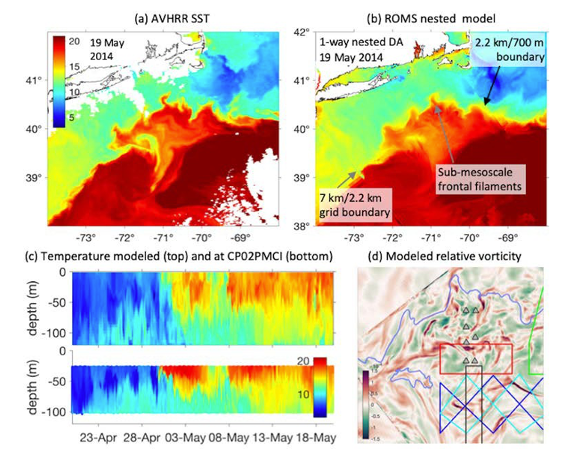A Data Assimilative Reanalysis at the New England Shelf Pioneer Array
John Wilkin, Department of Marine and Coastal Sciences, Rutgers University, New Brunswick, NJ, USA. Extracted from OOI Science Plan, 2021.
In the atmospheric sciences so-called reanalysis products are widely used for scientific discovery. These are the merger of observations with a dynamical model through a formal data assimilation process. In oceanography, due to novel observing technologies and burgeoning networks in which OOI is a key component, we are witnessing the emergence of high-resolution ocean reanalysis and forecast products that can support collaborative research in much the same way as in meteorology. Founded on Bayesian maximum likelihood principles, data assimilation balances a model with inaccuracies with data that incompletely sample the ocean to deliver an analysis that satisfies mass and tracer conservation principles and kinematic controls exerted by topography, while also being consistent with available knowledge of the true ocean state. Arguably, a skillful reanalysis offers the best possible estimate of the time varying ocean state from which to infer such quantities as across- shelf transport of mass, heat and salt.
Using 4-Dimensional Variational (4D-Var) Data Assimilation (DA) (Moore et al., 2011) and the Regional Ocean Modeling System (ROMS), (Levin et al., 2020a, b) have undertaken a 4-year retrospective reanalysis (2014- 2017) of ocean circulation at the Pioneer Coastal Array site. Starting from a 7-km resolution model identical to the MARACOOS real-time ocean forecast system (Wilkin et al., 2018), a hierarchy of two further 1-way nested grids refined the model resolution by a factor of three at each step to achieve ~700 m horizontal grid resolution at an innermost nest that fully encompasses Pioneer.
Applying 4D-Var DA within each successive grid, with appropriate background error covariance scales and data thinning etc., the system captures circulation features that range from Gulf Stream rings and meanders through an energetic mesoscale eddy field down to o(1) Rossby number flows that characterize the inhomogeneous, rapidly evolvingand ephemeral submesoscale circulation. As an example, Figure to the right shows surface temperature and relative vorticity during an across-shelf intrusion event studied by Zhang and Gawarkiewicz (2015) that was an early application of OOI data.
Beyond computing ocean circulation reanalyses, which is mostly straightforward though at this resolution very computationally intensive (a 2-year simulation of the 700-m grid with 4D-Var DA took two months on 144 cores of a high-performance cluster computer), the DA system can be used to gain insight as to the information content of the observing network itself.
One approach to this is Observation Impact Analysis (Langland and Baker, 2004), which deduces the contribution that each individual observation makes to some chosen scalar index that characterizes an important feature of the circulation; here, some 100,000 observations are assimilated each day from in situ platforms and satellites. Defining flow indices that quantify the net fluxes of mass, heat and salt across a transect following the 200-m isobath through the center of the Pioneer Array, (Levin et al., 2020a,b) applied Observation Impact Analysis to each successive nested grid data assimilation reanalysis.
Despite being an order of magnitude fewer in number, in situ observations of temperature and salinity from Pioneer moorings and gliders had two to three times the impact of satellite sea level and temperature data on the across-shelf fluxes in the 7-km resolution parent grid. Interestingly, while the influence of velocity observations was modest in the parent grid, this grew substantially as model resolution was refined to the extent that moored ADCP velocity data were twice as impactful as in situ T and S in the 800-m grid. This can be explained by noting that as the model resolution increases, vigorous sub-mesoscale motions spontaneously emerge with a higher ratio of kinetic to potential energy and the 4D-Var assimilation system is better able to utilize velocity data to inform a dynamically balanced analysis.
These studies have shown that it is feasible to compute sub-mesoscale resolution data assimilative ocean reanalyses, that are meaningfully constrained by dense observing networks such as Pioneer. Achieving event-wise correspondence between observed and modeled sub-mesoscale features, with a dynamically self-consistent analysis of velocity and density throughout the full water column, can provide context to the interpretation of other Pioneer data, and opens further opportunities, such as coupling the circulation model to companion models of biogeochemical and ecosystem processes.

